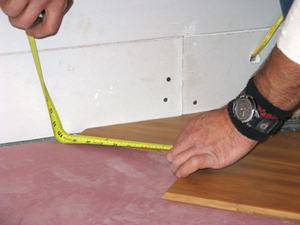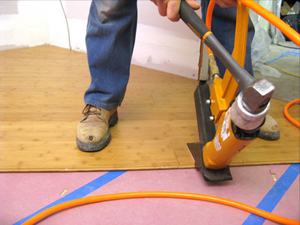Technical Data
Bamboo Flooring Installation
Best time to install bamboo flooring?
Room has high temperature during summer and when it goes into winter, bamboo flooring will have very obviously gap after shrinking.
Installation in winter, bamboo flooring will get swollen during summer. So the best time for installation is spring and autumn. If installation has to be done in summer, bamboo flooring has to be covered well, without sunshine and keeping room temperature below 30 centigrade.
Experienced professional installers of hardwood flooring will find themselves right at home installing bamboo hardwood flooring. Although every installer has a style of his own guidelines for installing bamboo flooring are the same as those recommended for installing hardwood flooring in general. Those recommendations have been developed over several years by The National Wood Flooring Association, The National Oak Flooring Manufacturers Association and The Hardwood Council.
Another good source of installing and finishing information can be found online at Wood Floors Online.
Some installation Basics

Designers, architects, builders or homeowners in a position of overseeing an installation by professional installers should keep in mind some simple "rules" that apply in the laying of any hardwood flooring.
Make sure the sub floor is dry, level and free of squeaks. Measure the moisture content of sub floor in several locations. Unpack the bamboo flooring and let it age in the room for a week to ten days.
All wood flooring, including bamboo flooring, displays some slight color variation board to board. Unpack and lay out ahead of the installer four or five cartons of bamboo flooring so that color variations can be mixed in a random pattern and not consolidated in a single area.
Begin laying the bamboo flooring from the end of the room that is aesthetic focal point. This way, the partial board that has to be top nailed or other corrections due to actual geometry of the room, occur at the visually "unimportant" end of the room.
Make certain that sufficient expansion space is left at the perimeter of the installation. In climate areas where the humidity of the room varies seasonally very little, a minimum expansion space of 6.35mm is recommended.

In areas where humidity variation is high from season to season, as in south-central United States, an expansion space of 19mm is suggested. The bamboo hardwood flooring behaves in a similar fashion to other hardwoods; your local professional installer should be your "expert" source on this as well as other installation and finishing questions.
The end joints of the bamboo flooring should be randomly positioned one to another to avoid visually symmetrical patterns like "stair casing".
Some finishing suggestions
We recommend three sandings. A 60 grit sanding, following by 100 grit polishing and then a "buffing" 150. With the solvent-based coatings for all types of floors is better from a wear standpoint.
For those non-professionals who want to acquire more solid oversight-skills for flooring installation and finishing techniques, we recommend reviewing "Hardwood Floors. Laying, Sanding and Finishing" by Don Bollinger. This is an excellent, clearly-written, illustrated resource for layman and professional alike from the Fine Homebuilding series published by The Taunton Press in Connecticut.
In finishing bamboo flooring, we have had good success with solvent-based polyurethane from Bona Kemie; one sealer coat followed by a buffing to smooth the grain and then two top coats. A water-based urethane is often preferred because the odor during installation is minimum.


 皖公网安备 34180202000049号
皖公网安备 34180202000049号